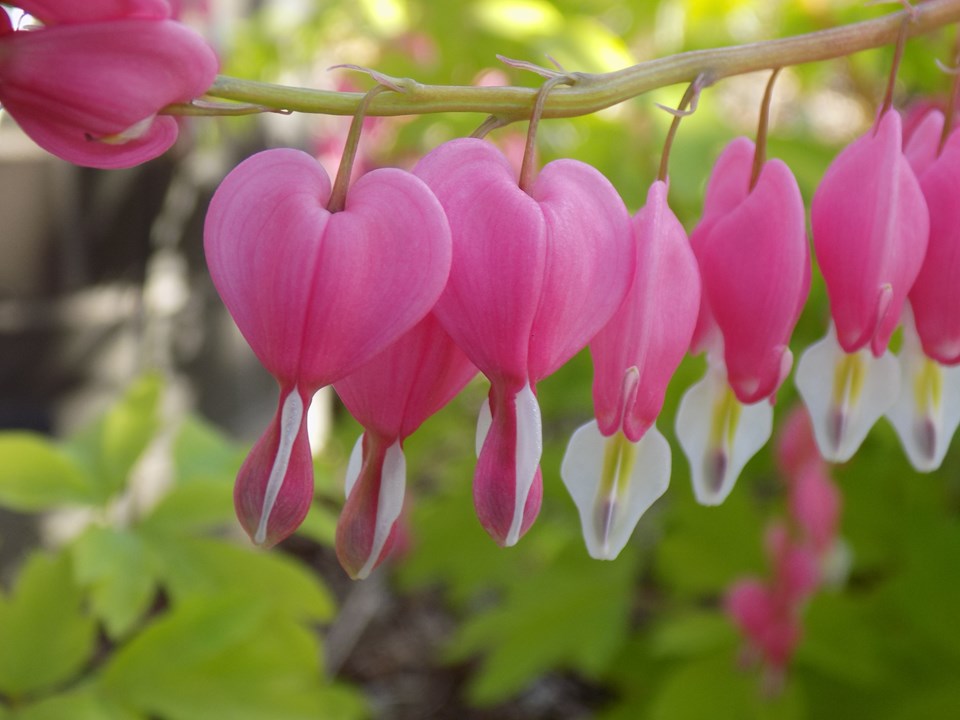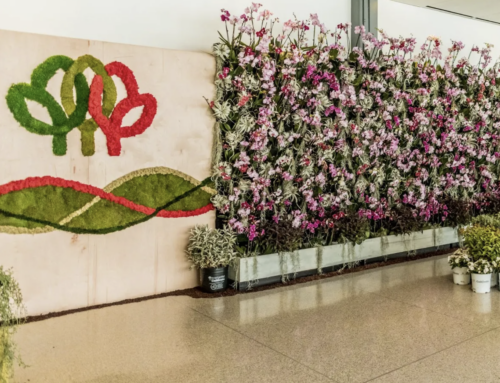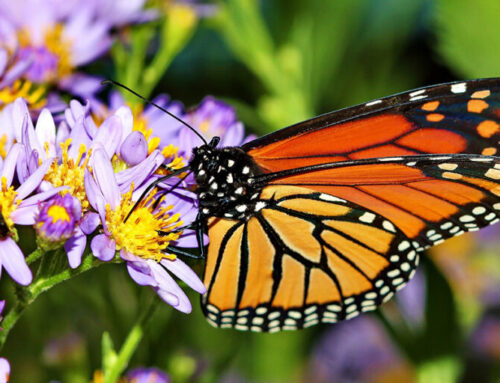With St. Valentine’s Day coming soon we might consider gifts of the plant type for those special people in our lives. Last year at this time, we posted a story, Plants that Enhance Romance suggesting alternatives to a short-lasting bouquet of cut flowers. Though we acknowledged a vase of roses is a powerful statement, giving a plant that lives beyond a week or two and potentially for years, has its merits. The lovely alternate plants we suggested in that posting were African Violets, Cyclamen, Orchids, and the Flamingo Lily – all honorable houseplants. This year we step outside the house for a sweetheart of a selection, the perennial Bleeding Heart.
Bleeding Heart (formerly known as Dicentra, since changed to Lamprocapnos) is one of the earlier blooming perennials of late spring/early summer. It is encouraging to see the bright green foliage breaking through brown leaves in the beds. I recall the rate of their rise (growth expansion) is exceptional. My Bleeding Hearts actually grow beneath a large Bottle-brush Buckeye (and I confess I don’t recall planting them there). Well before the huge leaves of the shrub above develop, the Bleeding Heart is up and expanding into a 1.5-2’ plant. By the time flowers appear, the plant can be 2.5’ tall and 1.5’ wide.
The flowers – are like no other. Imagine puffy, little heart-shaped pillows ranging from pink, red and white. Blooms dangle gently along a horizontal stem, like hearts on a string. Not only will they catch your eye but hummingbirds are attracted to them as well. In the north, we typically need to wait until May, but warmer parts of the country will see flowers in April. The bloom show can last several weeks to a month, as summer heat comes on the plants fade and disappear. Don’t be alarmed, they will return the flowering spring. In some temperate regions, plants are known to rebloom in the autumn.
There’s a fascinating, perhaps oddly risqué attribute of the plant, shown to me by an old friend in my youth. Taking the outside petals and gently pulling outward, as the inner white petal slowly rises upward it gives the impression of a naked lady rising from a bathtub – no lie. Unfortunately, since we are in the dead of winter, I need to leave that to your imagination for now. When they bloom this May, I will repost this phenomenon with an update on the Bleeding Heart hopefully demonstrating this scandalous image of a botanical nature.
Ideal conditions for growth are full shade to light shade. Though mine grows beneath a large tall shrub, I believe it would develop more blooms with dappled sunlight. The rich humus of a woodland is an ideal soil as well as being well-drained, but it fits nicely into a shade garden with complimentary conditions. Hardiness spans from Zone 3 to Zone 9.
There are two distinct Bleeding Heart species commonly grown:
The common Bleeding Heart, some may list as the traditional or old fashion species Lamprocapnos spectabilis. Most images in this posting are of the traditional L. spectabilis. Less common, yet interesting for its own qualities is the Fringed Bleeding Heart Lamprocapnos eximia.

The Fringed Bleeding Heart, note the finely dissected compound leaves being a feature in itself.
The Fringed Bleeding Heart is often smaller and more compact. The attractive fern-like foliage alone adds fine texture to the garden setting, with flowers on top as a bonus. Though the Fringed Bleeding Heart may not be as spectacular in bloom, unlike the larger traditional species, it can continue to bloom throughout the summer.
Some of the more readily available varieties of Bleeding Heart include ‘Alba’ a white flower, and ‘Gold Heart’ with gold or chartreuse leaves.

Bleeding Heart, ‘Gold Heart’ variety with chartreuse foliage
:max_bytes(150000):strip_icc():format(webp)/growing-bleeding-heart-plants-1402834_03-67a09f0b55c046d6bcac29d55dc5d9de.jpg)
-Rob McCartney, Horticulturist
Please feel free to contact me with any questions or for more info at: [email protected]
Connect with us on social media!
Instagram | Facebook | Twitter | Website
With St. Valentine’s Day coming soon we might consider gifts of the plant type for those special people in our lives. Last year at this time, we posted a story, Plants that Enhance Romance suggesting alternatives to a short-lasting bouquet of cut flowers. Though we acknowledged a vase of roses is a powerful statement, giving a plant that lives beyond a week or two and potentially for years, has its merits. The lovely alternate plants we suggested in that posting were African Violets, Cyclamen, Orchids, and the Flamingo Lily – all honorable houseplants. This year we step outside the house for a sweetheart of a selection, the perennial Bleeding Heart.
Bleeding Heart (formerly known as Dicentra, since changed to Lamprocapnos) is one of the earlier blooming perennials of late spring/early summer. It is encouraging to see the bright green foliage breaking through brown leaves in the beds. I recall the rate of their rise (growth expansion) is exceptional. My Bleeding Hearts actually grow beneath a large Bottle-brush Buckeye (and I confess I don’t recall planting them there). Well before the huge leaves of the shrub above develop, the Bleeding Heart is up and expanding into a 1.5-2’ plant. By the time flowers appear, the plant can be 2.5’ tall and 1.5’ wide.
The flowers – are like no other. Imagine puffy, little heart-shaped pillows ranging from pink, red and white. Blooms dangle gently along a horizontal stem, like hearts on a string. Not only will they catch your eye but hummingbirds are attracted to them as well. In the north, we typically need to wait until May, but warmer parts of the country will see flowers in April. The bloom show can last several weeks to a month, as summer heat comes on the plants fade and disappear. Don’t be alarmed, they will return the flowering spring. In some temperate regions, plants are known to rebloom in the autumn.
There’s a fascinating, perhaps oddly risqué attribute of the plant, shown to me by an old friend in my youth. Taking the outside petals and gently pulling outward, as the inner white petal slowly rises upward it gives the impression of a naked lady rising from a bathtub – no lie. Unfortunately, since we are in the dead of winter, I need to leave that to your imagination for now. When they bloom this May, I will repost this phenomenon with an update on the Bleeding Heart hopefully demonstrating this scandalous image of a botanical nature.
Ideal conditions for growth are full shade to light shade. Though mine grows beneath a large tall shrub, I believe it would develop more blooms with dappled sunlight. The rich humus of a woodland is an ideal soil as well as being well-drained, but it fits nicely into a shade garden with complimentary conditions. Hardiness spans from Zone 3 to Zone 9.
There are two distinct Bleeding Heart species commonly grown:
The common Bleeding Heart, some may list as the traditional or old fashion species Lamprocapnos spectabilis. Most images in this posting are of the traditional L. spectabilis. Less common, yet interesting for its own qualities is the Fringed Bleeding Heart Lamprocapnos eximia.

The Fringed Bleeding Heart, note the finely dissected compound leaves being a feature in itself.
The Fringed Bleeding Heart is often smaller and more compact. The attractive fern-like foliage alone adds fine texture to the garden setting, with flowers on top as a bonus. Though the Fringed Bleeding Heart may not be as spectacular in bloom, unlike the larger traditional species, it can continue to bloom throughout the summer.
Some of the more readily available varieties of Bleeding Heart include ‘Alba’ a white flower, and ‘Gold Heart’ with gold or chartreuse leaves.

Bleeding Heart, ‘Gold Heart’ variety with chartreuse foliage
:max_bytes(150000):strip_icc():format(webp)/growing-bleeding-heart-plants-1402834_03-67a09f0b55c046d6bcac29d55dc5d9de.jpg)
-Rob McCartney, Horticulturist
Please feel free to contact me with any questions or for more info at: [email protected]




